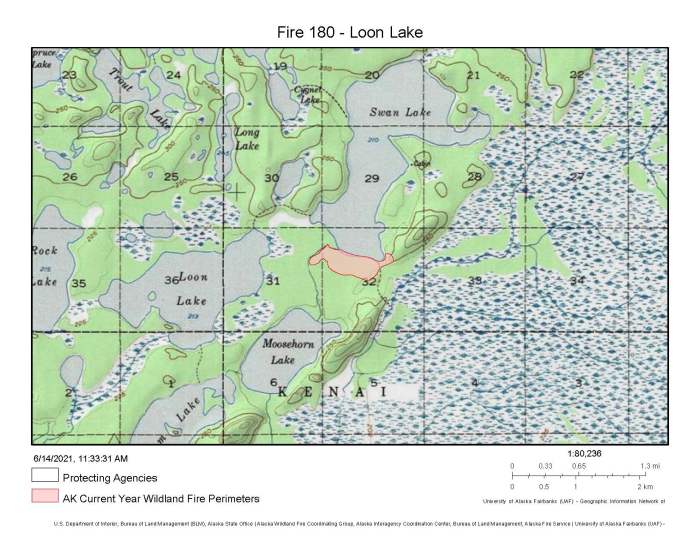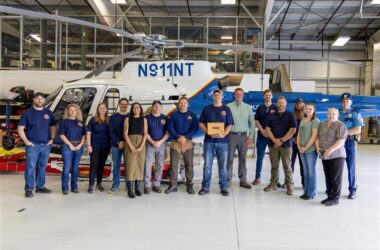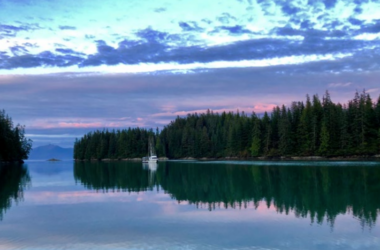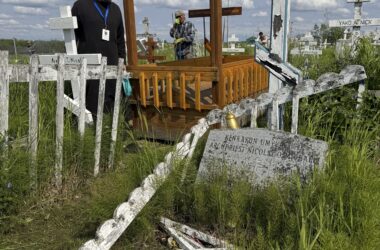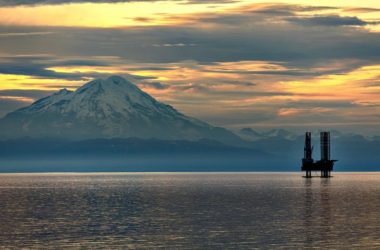06/15 6:00 AM UPDATE: Fire crews working the 75 acre Loon Lake Fire located in the Kenai National Wildlife Refuge wilderness are cutting the fireline and mopping up.
In a Monday evening video update, Kale Casey, Public Information Officer with the Alaska Division of Forestry:
The Moose River is providing crews with plenty of water for hose lays along the eastern flank. Type 3 Incident Commander Bryan Quimby assumed command Monday with the goal of full 100% suppression of this lightning caused fire. Two more hotshot crews – the Pioneer Peak Hotshots from the Division of Forestry and Midnight Sun Hotshots from the Bureau of Land Management Alaska Fire Service – arrived to the scene and flew to the fire to join the Gannett Glacier Initial Attack crew to bolster containment work on the ground.
The fire is burning in a limited protection area and does not currently pose a threat but Refuge managers have elected to take 100% suppression of the fire. The Alaska Division of Forestry is coordinating with Refuge managers to formulate a suppression plan for the fire.
06/14 2:00 PM UPDATE: The Loon Lake Fire that was burning up to 150 acres in the Kenai National Wildlife Refuge over the weekend had been reduced to 75 acres as of Monday morning. Little growth was expected Sunday night into Monday following an aggressive aerial attack in response to increased fire activity Sunday afternoon. The fire was 15% contained as of Monday morning.
Andy Alexandrou, Public Information Officer with the Alaska Division of Forestry:
“The smoke cleared last night and we got more people out on the ground and they circumnavigated the fire. Through that, and better viewing from the air, they remapped the fire. Before they made it like a big rectangle, now they put a perimeter in the actual fire perimeter. This could possibly change again, but that’s what modified the 150 acres to roughly 75 acres.”
Alexandrou says that multiple aircraft bombed the fire:
“The retardant plane delivered 7,700 gallons of retardant to the perimeter. They made one line the length of the fire. That was a prescedent set by the graces of the U.S. Fish and Wildlife Services, that’s the land manager for this fire. Usually, you don’t use retardant in a wilderness area cause that area is designated wilderness area. So they utilized just three loads, they authorized that for efficiency and how efficient the retardant would be to retard the spread of the fire. We have two fire bosses, the guy delivered 48,300 gallons of water on the fire yesterday.”
An air tanker dropped another 10,000 gallons of water on the fire. Both the water and retardant drops reduced the fire behavior significantly and the fire was producing very little smoke as of 11:30 a.m. Monday.
The focus is securing the south flank to prevent fire spread towards the community of Sterling and the Sterling Highway. Also, a Temporary Flight Restriction was put in place over the fire to ensure a safe environment for aircraft working on the fire.
The fire, reported at around 8 p.m. Saturday, is burning in dense black spruce only about 1 mile from where the Swan Lake Fire was started by lightning on June 5, 2019. The Loon Lake Fire is burning in a remote area of the refuge about 10 ½ miles northeast of Sterling and does not pose a threat to the community, highway or any other values. It is burning next to Loon Lake and about one-half mile from Swan Lake.
06/14 12:00 PM UPDATE: The fire behavior of the 150-acre Loon Lake Fire Sunday evening was reduced through water-scooping aircraft and water and retardant drops from an air tanker.
Howie Kent, Kenai/Kodiak Area Fire Management Officer with the Alaska Division of Forestry:
“We spent the bulk of yesterday utilizing aircraft to help slow the spread of the fire. The fire was pushed by wind and it pushed to the northeast. At last report, it was reported at about 150 acres, although I think it’s a little bit smaller than that. probably somewhere under 100 acres. Crews are getting put in place out there. We’ve got the Gannett Glacier Crew, they’re a Type 2 I A in place. We’ve got Pioneer Peak hotshots arriving this morning. We’ll be shuttling that crew out to the fire and then this afternoon, we’ll have the Midnight Sun hotshots here and so we’ll be shuttling them out. So we’ll have three crews in service by the end of today. The fire was looking pretty good as of last night, laid down quite a bit, with the utilization of the aircraft that we had available to us and should be looking to get that thing out in a better spot by the end of shift today.”
Kent speaks on the game plan for today:
“We have the fire at a type four incident level and we’ve moved that to a type three so we’ve notched up one level and so we’ll be doing a transition today between the incident commanders, the IC4 out there and we’ve got a type 3 organization that we’re going to put in place. It’s just a matter of getting the crews in place and then all of the logistic support to help support those crews to be able to contain that fire.”
In the event the winds pick up again, Kent said:
“We’re taking measures now to kind of plan for that. we’ve got plenty of aircraft available to us. We’ve got a couple of fire bosses down from Fairbanks yesterday to assist us. We brought on a heavy helicopter to do bucket work out there to assist our initial attack helicopter and bucket work operations. We’ll bring in a third helicopter on today to help with the crew shuttles to get people out on the fire line faster.”
The fire, reported at around 8 p.m. Saturday, is burning in dense black spruce only about 1 mile from where the Swan Lake Fire was started by lightning on June 5, 2019. The Loon Lake Fire is burning in a remote area of the refuge about 10 ½ miles northeast of Sterling and does not pose a threat to the community, highway or any other values. It is burning next to Loon Lake and about one-half mile from Swan Lake.
06/14 6:00 AM UPDATE: Aircraft from the Bureau of Land Management Alaska Fire Service helped reduce the fire behavior of the 150-acre Loon Lake Fire last evening of a lightning-caused fire that began Saturday night. It had been burning in the Kenai National Wildlife Refuge that included water drops from two water-scooping aircraft and water and retardant drops from an air tanker. The water drops significantly reduced fire behavior. The retardant drops were meant to pen the fire in and give firefighters on the ground a chance to begin building containment lines. The 17-person Gannett Glacier Type 2 Initial Attack Crew has been flown into the fire and will be joined on the fireline by the Midnight Sun and Pioneer Peak hotshot crews today.
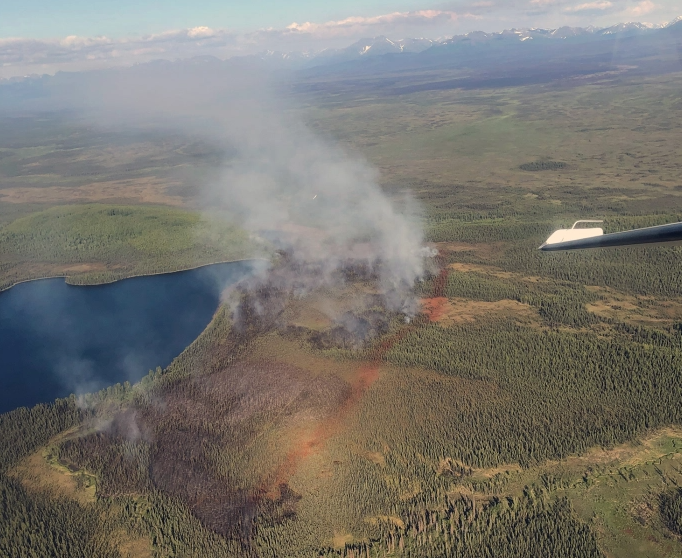
ORIGINAL: The Loon Lake Fire (#180) burning in the Kenai National Wildlife Refuge became more active this afternoon, according to the Alaska Division of Forestry. DOF is responding with water and retardant drops from multiple aircraft and more personnel have been ordered to fight it.
A photo of smoke being produced by the Loon Lake Fire (#180) taken by Alaska Division of Forestry Air Attack personnel Sunday, June 13, 2021 at approximately 3 p.m.
A photo of the Loon Lake Fire (#180) taken by Alaska Division of Forestry Air Attack personnel Sunday, June 13, 2021 at approximately 3 p.m. As of 5 p.m. the fire was estimated at 150 acres. Jason Jordet/Division of Forestry Fire managers report the lightning-ignited fire has grown from about 6 acres this morning to an estimated 150 acres as of 5 p.m. A significant smoke column from the fire is visible from the Sterling Highway and other areas of the Kenai Peninsula. The Division of Forestry and Alaska State Troopers have received multiple calls from concerned residents.
The fire, reported at around 8 p.m. Saturday, is burning in dense black spruce only about 1 mile from where the Swan Lake Fire was started by lightning on June 5, 2019.
The Loon Lake Fire is burning in a remote area of the refuge about 10 ½ miles northeast of Sterling and does not pose a threat to the community, highway or any other values. It is burning next to Loon Lake and about one-half mile from Swan Lake.
An air tanker based in Palmer has made multiple water drops on the fire and two water-scooping aircraft based at the BLM Alaska Fire Service continue to bomb the fire with water drops. A helicopter from the Kenai/Kodiak Area Forestry station has also been making water drops on the fire and another helicopter has been hired for additional bucket work.
Refuge managers have given the Division of Forestry permission to drop retardant around the fire to slow its progress. Fire managers are thee retardant drops around the active portion of the fire to pen it in and give firefighters on the ground a chance to attack and begin constructing containment lines.
The 17-person Gannett Glacier Type 2 Initial Attack Crew is being helicoptered into the fire and should be on the fireline by 7 p.m. Two more hotshot crews – the Pioneer Peak Hotshots and Midnight Sun Hotshots – have been ordered and will arrive at the fire tomorrow.
The Loon Lake Fire was reported at approximately 8 p.m. Saturday following several lightning strikes in the area. The Loon Lake Fire was initially reported at 2 acres but grew to nearly 6 acres as of this morning.

